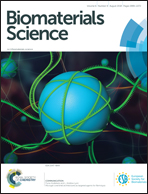Comparative studies of the serum half-life extension of a protein via site-specific conjugation to a species-matched or -mismatched albumin†
Abstract
Human serum albumin (HSA) has been investigated as a serum half-life extender of therapeutic proteins thanks to its unusually long serum half-life. However, in mice, the serum half-life of a HSA-conjugated protein was much shorter than that of HSA in humans, likely due to the species-dependent nature of albumin–FcRn interactions. Herein, we investigated species-dependent albumin–FcRn interactions using species-matched albumin (mouse serum albumin) and species-mismatched albumin (HSA) in non-transgenic mice. We site-specifically introduced a clickable non-natural amino acid to a target protein followed by conjugation to an albumin species via a hetero-bifunctional linker. Using in vitro binding assays, we showed that both HSA- and MSA-conjugated proteins bound mouse FcRns. Conjugation of HSA led to very limited extension of the serum half-life of sfGFP in mice (16.3 h), compared to that of HSA in transgenic mice harboring an allele of mouse FcRn knock-out and expressing humn FcRn (67 h) reported previously. These results suggest that the FcRn-mediated recycling of HSA is not effective in mice. However, conjugation of mouse serum albumin (MSA) resulted in a serum half-life of sfGFP (27.7 h) comparable to that of MSA in mice (28.8 h). Altogether, our study supported that albumin–FcRn interactions are species dependent in vivo.



 Please wait while we load your content...
Please wait while we load your content...